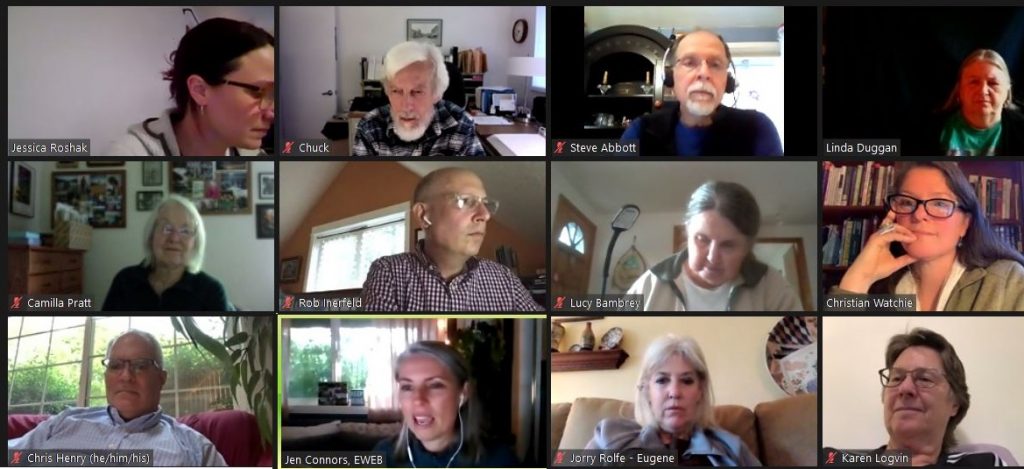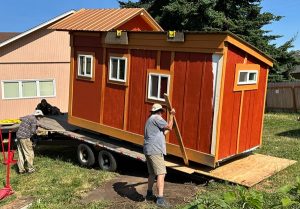EWEB briefs neighborhood on ‘once-in-a-lifetime’ water tank project
5 min read
EWEB alerted the neighborhood that construction will start on Patterson Hill in early August.
Jen Connors: EWEB purchased a 10 acre property about 70 years ago, since the 1950s, for this very purpose, for constructing a future water storage facility when it was needed by the community. And that time has come.
John Q: [00:00:14] Jen Connors from EWEB told Southeast Neighbors about a once-in-a-lifetime public works project. Hosting the discussion: Jess Roshak.
Jess Roshak: [00:00:24] And we’re going to hear from Jen Connors, and anyone else from EWEB who’s here. Jen?
Jen Connors: [00:00:30] Thanks, Jess. I have some just heads up information to share with you about a project that’s happening in Southeast Eugene. This is a water storage construction project that is going to be starting in the next few months, off of 40th and Patterson. In the stretch between the Safeway on 40th, and Hilyard, there’s that small stretch of Patterson Street that runs south, off of 40th. It’s a dead end street. And some of you may be familiar with the undeveloped property that’s there at the end of Patterson.
We’ve been doing active planning and neighbor outreach since early 2020. And we’re now at the phase where we’re getting ready to break ground at the site, in early August of this year.
Thank you for supporting
local citizen journalism
The whole construction process is expected to last about three years. And that’s from the very early fencing to taking out trees, earthwork, construction of the tanks and then re -landscaping and re-vegetating the site. It’s going to be about a three-year process. These tanks, by the way, are partially-buried concrete round tanks. So I just want to be clear. They’re not like the elevated water storage tanks that you may be familiar with, from other areas in town.
John Q: [00:01:46] Jen said at times there will be 200 truck trips per day.
Jen Connors: [00:01:50] The earthworks phase, in particular, is going to create some heavy truck traffic beginning this fall and lasting for six to 12 months. The most significant traffic impact will be on that stretch of Patterson Street, which is a residential street. There are about nine homes on that dead end street.
As far as the truck routes themselves, the contractor gets to determine that. We haven’t selected a contractor yet for the earthwork. We’re going through the public bidding process now. But the contractor will select what route the trucks come in to the site and where they leave. But if you know that particular area of the neighborhood, coming north on Hilyard Street past Tugman Park makes the most sense.
For context, there’s about 5,000 truck trips past Tugman Park already right now. And during this earthwork phase, that will probably increase by about 200 trucks a day. A hundred going to the site and then taking the rock and earth and going back the other way. So it’s not insignificant.
After the six-to-12-month earthwork phase, there will still be construction at the site for another couple of years, but the truck traffic will decrease significantly. It’s really during that earthwork phase that neighbors in the area are going to notice the most traffic. It won’t be constant. It will be intermittent during approved construction hours. Those are regulated by the city. So there will be some days where it’s pretty heavy and then some days where it’s pretty light. It won’t be continuous.
John Q: [00:03:23] Chuck wondered about possible alternatives that would affect fewer neighbors.
Chuck: [00:03:28] Yeah, if I’m not mistaken 40th, right, oh, down near Ferry Street, there’s a back entrance to the EWEB site. It’s a gated thing and it’s got, it’s a dirt path right now. Is there any intention to use that? And if not, why not? Because it only impacts probably fewer houses than what are on Patterson Street.
John Q: [00:03:53] EWEB’s Laura Farthing, project engineer and senior civil engineer.
Laura Farthing: [00:03:59] I can take that, Jen, if you want. We did look at using that as an option. The problem is that there’s a portion of the oak woodland savanna that’s on the site that has some really healthy, bigger, old oak trees. So we would have to cut down all of the 200-year-old oaks in order to get the traffic to route through the site that way. And we can route the dump trucks through those trees and save them. So we looked at laying a road out in order to loop the traffic around, which actually would make the earthwork go faster. We did look at that as an option, but that is why we were not able to use it.
John Q: [00:04:33] Laura Farthing mentioned other aspects of the historic project.
Laura Farthing: [00:04:37] I have been working with talking to a couple of teachers at the Spencer’s Butte Middle School, about finding opportunities in order to bring the students in. We’re doing small restoration work and seeing if we can bring them in to do some, work on native plants and things like that. And then also looking at bringing in different school groups in different ages for tours of the construction site and how things get built.
Jess Roshak: [00:04:59] Linda, last question.
Linda Duggan: [00:05:01] I have some concerns about the trucks and the traffic, starting with Nightingale is right on the corner, and Good Samaritan, and then Tugman Park. I do have some concerns on Hilyard, not just Patterson up there, but Hilyard and I think it’s going to be impacting people in the park, et cetera.
John Q: [00:05:22] Lucy Bambrey also asked about project safety. Laura Farthing.
Laura Farthing: [00:05:27] All of the construction projects that I personally have been an engineer on it, you end up with a lot of people who start coming out from the community. Because it’s not every day you get to watch large infrastructure be built, especially one that is in your back yard. And so we do try to set up areas where people can safely see what’s going on. And we do take safety very seriously. Anyway, it’s one of our core values.
John Q: [00:05:51] Jen Connors talked about an upcoming event: Electric vehicles!
Jen Connors: [00:05:56] The Emerald Valley Electric Vehicle Association, EVEVA, and a couple of other local partners, will put on a free workshop. It’s June 17th at 7:00 PM. It’s online. And it covers things like, what are the benefits of owning electric vehicles? How much do they cost? And then just keep an eye out for new electric mobility program offerings coming soon around electric bikes. You can keep tabs on that at https://eweb.org/ev.
John Q: [00:06:23] Southeast Neighbor Linda Duggan.
Linda Duggan: [00:06:25] Just a quick comment, for your information. Our Southeast Neighbors Transportation Committee, part of our suggested proposal plan for LTD was to make Amazon Station into a hub, and include electric recharging. We’re trying to keep our neighborhood buses and have it be a hub at Amazon Station, and part of that could be also for renting bikes, charging bikes, et cetera.
Jen Connors: [00:06:54] Thank you, Linda.
Jess Roshak: [00:06:55] And that might be something that (City of Eugene Transportation Planning Manager) Rob (Inerfeld) and his team are interested in coordinating on as well.
John Q: [00:07:00] Neighborhood leaders hope the removed trees can be used for benches, and remain in neighborhood parks.



